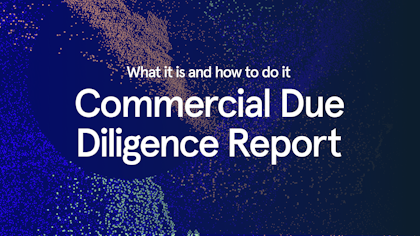Deal-making is glamorous; due diligence is not. This simple quote by Bain’s former PE Director, Geoffrey Cullinan, goes a long way toward explaining why so many companies have made so many acquisitions that have produced so little value. Due diligence all too often becomes an exercise in verifying the target’s financial statements rather than thoroughly evaluating the strategic fit of the deal and the acquirer’s potential to generate value from it.
This is where the commercial due diligence report comes in.
Whether you’re a seasoned investor, a management consultant, or an entrepreneur considering a business acquisition, understanding the ins and outs of commercial due diligence is essential. In this post, we’ll explore commercial due diligence reports, why they’re important, and how to structure a best-practice report. We’ll also share tips and tricks for your process based on our experiences at McKinsey, BCG, and Bain.
What is a commercial due diligence report?
When engaging in an M&A process, the investor/acquirer will want to conduct a comprehensive due diligence of the target company to understand if it is overall a good investment.
The due diligence encompasses many areas of the company, with the commercial due diligence being a cornerstone of the process.
A Commercial Due Diligence (CDD) report is a systematic, thorough investigation of a target company’s market position, competitive environment and growth prospects.
The main objective of the commercial due diligence is to answer the question: is this a good business to be in?
This involves analyzing market and customer dynamics, mapping the competitive landscape, and understanding the target’s competitive advantage and financial strength to identify opportunities and mitigate risks.
Why is a commercial due diligence report important?
The commercial due diligence report is important due to several factors:
- Establishes value and price: The main purpose of a CDD is to understand and evaluate the target’s competitive position thoroughly. This helps understand the target’s short—and long-term value and, therefore, potential price.
- Mitigates risk: A CDD identifies and rates risks so investors or acquirers can develop mitigation strategies, renegotiate deal terms, or decide against pursuing the deal altogether.
- Identifies opportunities: The CDD also helps identify and quantify potential opportunities or sources of untapped value in the target, such as overlooked market segments, operational efficiencies, or potential synergies with the acquirer.
- Ensures strategic alignment: A CDD establishes a clear picture of the target’s strategy (both theoretical and actual) and thereby helps an acquirer assess the potential strategic fit.
- Allows for smoother post-merger integration: A thorough understanding of the target’s market position and strengths and weaknesses enables the acquirer to create and implement integration plans more efficiently, leading to faster achievement of desired outcomes and value creation.
How do you write a report on due diligence?
To write a good due diligence report, you need to remember three things:
- Objective: Put yourself in the shoes of the acquirer and ask yourself which questions you need to answer to give the acquirer peace of mind to move forward with the transaction
- Structure: Structure your due diligence report in a logical, tried-and-tested way to make it as easy as possible to digest for the acquirer/audience
- Formatting: Layout your slides, edit your text, format your graphs etc. using best-practices from consulting to ensure your messages are clear and your report is cohesive
Let’s dive into each of these points.
Objective of a due diligence report
First and foremost, you should have a very clear picture of which questions the acquirer/recipient of your due diligence report wants to have answered. What is their objective with the acquisition? What are they nervous about? Where do they have blind spots that you can dig deeper into and make sure are covered?
To do this, you need to adopt an investor mindset and think through all important scenarios. The easiest way to do this is by using a first principles approach, where you systematically unfold and dive deeper into key aspects of a business.
See the figure below for an example of this type of approach.
If you find yourself struggling to formulate questions, then it’s most often a sign that you’ve over-complicated things and need to take a step back and rethink your questions. Good questions likely feel simple and almost obvious when stating them but are surprisingly hard to answer.
Due diligence report structure
Second, use a simple and logical structure for your due diligence report. The due diligence report format is often built up around the key areas you answer during the commercial due diligence process and which often mirrors the questions you defined when thinking through the objective, i.e., market analysis, competitive landscape, customer analysis, etc.
Depending on your particular type of business and target company, you’ll likely not include all sections but only the ones that are of particular importance for the target company's situation.
The main sections should then be bookended by answers and process pieces.
In the beginning, you want to first follow the pyramid principle by including a solid executive summary that emphasizes the answers and recommendations. See our guide on writing executive summaries like McKinsey and BCG in this article here.
Following this, you want to include an introduction to the due diligence project that sets the scene and lays out how the analysis has been conducted and potentially which limitations you’ve encountered. This will help the recipients understand how thorough the due diligence has been, and how it fits into an overall timeline.
After your main section with the commercial due diligence components, the natural flow leads to a financial modeling section where you examine the numbers of the potential transaction and essentially decide if the target company is a good and healthy purchase.
Following this, you’ll likely want to include a risks and synergies assessment. This will help identify where the red flags and opportunities are based on the previous research and highlight it in an easily digestible manner to your recipients.
The due diligence report then ends with your recommendations i.e., the main answers of the due diligence process and what this means for the recipients/acquirer, as well as immediate next steps and a longer plan post-acquisition.
Most due diligence reports also include several lengthy appendices to contain all the research that could not be included in the main report so the recipients can find answers to follow-up questions or confirm details.
Due diligence report formatting
Third, remember that a due diligence report is just like any other presentation in the sense that its main purpose is to convey information to the recipients in as clear and concise a manner as possible.
This means you should use all the normal tools in a consulting toolbox to take your presentation from good to great. Examples of this are:
- Using action titles consistently to help guide readers
- Sticking to the golden rule of one-message-per-slide
- Keeping the pyramid principle in mind when structuring both the full storyline and each individual slide
- Summarizing your recommendations in a precise way
- …and many more useful slide skills that you can find in our Resources library here
Best practices for creating due diligence reports
- Create a skeleton of your final report and financial model(s) as early as possible: You won’t have many (or any) answers but set up a PowerPoint presentation with the sections and dummy slides you assume you’ll have in your final report, as well as a dummy Excel model for whatever financials you think you need (a good place to start is with a profit/EBITDA model). This will help focus your work and all your research and analysis.
- Align on scope with your team and the investor, if relevant: Use your skeleton presentation to make sure your relevant stakeholders agree on the sections you plan to include and what you plan to focus on. Ideally, get an idea of what each important stakeholder views as a successful output of the project (e.g., which questions do they want answered, what type of output/how detailed do they expect it to be) and play this back to them to make sure you’re working towards it.
- Book internal and external interviews and meetings quickly: Meetings and interviews are harder to organize than desktop research, so spend time in the beginning booking these before diving into desktop research. If you find out you don’t need the interview after all, either cancel or (if it’s an internal stakeholder) use the time to get them onboard and align on progress and results so far.
- Strive for good enough to get an answer: CDDs are typically short and intense, and you’ll never get perfect data or 100% complete answers. If you can’t find good data on your market, use comparable markets and approximate. Just make sure you and your stakeholders understand where you’ve cut corners and how this impacts your findings.
- Use the classic consulting toolbox: Use all the efficiency tools of a traditional consulting project i.e., top-down hypothesis-driven problem solving, the MECE framework, the pyramid principle for presentations, the 80-20 approach to research etc.
Using the approach outlined in this article will help you craft top-tier commercial due diligence reports in an efficient and effective way.



















